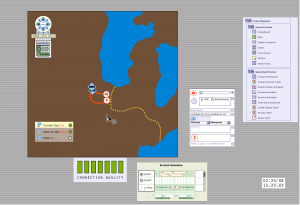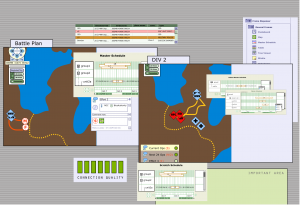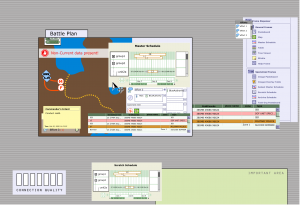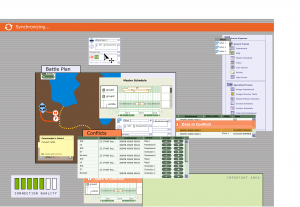Project Context:
Internally, General Dynamics C4 Systems-Viz created a new distributed, disconnected operations architecture. It promised to increase the number of desktop applications supported and allow the desktop application to disconnect and reconnect seamlessly. The United States Army requested a detailed proposal for re-architecting the Command Post of the Future (CPOF) to use this new architecture.
Project Description:
My research work to identify Warfighter Activities and User Vignettes provided the end user and UI perspective on the 3 year, $30 million proposal. Winning the proposal, these techniques were instrumental in communicating with the customer, as they conveyed the user experience. At the end of the proposal brief, the customer explicitly complemented the proposal team on the User Vignettes.
Warfighter Activities document the key usage scenarios of the current software. They describe the warfighters, their roles and responsibilities, and the tasks they perform to accomplish their jobs. They intentionally do not mention any software in order to concentrate on the people, their goals, and the surrounding business processes.
User vignettes focus on how a particular end user might accomplish a warfighter activity. They describe a warfighter interacting with the software at each incremental release. They use a realistic persona and UI sketches to step through the user interactions and system behaviors.
User-centered design methods: Context of Use Analysis, Envisionment Stories, Storyboards
Examples:
Warfighter Activity: Command Operation Center – Briefing
Everyday the there is a Division-level Commander’s Update Briefing (CUB) where the Commander learns about the latest information from the battlefield. The Commander leads this CUB from the command post where much of his staff sits. The room is set up so that he looks at the large projection of one staff member’s screen on the wall. His staff members prepare a short brief, as do some of the subordinate units. The agenda is organized in advance with each of the presenters speaking in turn. During the briefing, visuals, provided by the presenter, accompany the spoken communication and are available for everyone to view. For example, the Operations staff member shows the Division operations conducted in the last 24 hours, those ongoing, and the ones planned for the next 24 hours.
Warfighter Activity: Planning
One of the responsibilities of a Brigade Operations Officer is to plan upcoming missions. To do this, he annotates a geographic map with icons, text, and military standard tactical graphics. This map conveys the battlespace geometry, including the units involved, their responsibilities, and the overall battle plan. In planning the mission, the Operations Officer considers the Commander’s intent, the objectives the mission is to accomplish, and the environment it will be carried out in. He researches the enemy resistance expected, including the number of men his troops are likely to face and their likely lines of defense. He also investigates which units, equipment, and resources will be available at the time of the mission. He chooses the best unit for the job and ensures that they will have ample supplies and support. This planning includes collaboration between the primary staff officers to include the Intelligence and Logistics staff sections.
User Vignette: The last incremental releases
Captain Carline is a Brigade-level S3 Planner, who uses CPOF to collaborate with a vision to plan future missions. CPT Carline’s post is remote, unlike the Division’s, and he struggles with an intermittent, tactical network connection. Some times he has a connection, other times he does not, and often he has a weak connection to the network.The latest version of CPOF is ideal for CPT Carline because he can always access his battle plans and update them independent of the network connection situation. The user interface includes a “Connection Quality” tool to monitor the quality of his network connection, which lets him know when data within the system is not likely to be available. It also keeps him aware of the ideal times when all of the data is accessible. CPT Carline uses this information to adjust his interactions and the tasks he completes with the software accordingly.On one occasion, CPT Carline needs to coordinate with his counterpart officer in an adjacent Division. The mission he is planning will occur near the boundary separating their two Divisions’ Areas of Operation. He needs to make sure that this neighboring Brigade is both aware of the mission and available to provide support, if needed. Using CPOF, he shares his “COA” pasteboard for the mission with the adjacent unit’s plans officer, configuring it such that he can view and modify pieces as the plan develops. Similarly, CPT Carline looks at the neighboring Brigade’s information, referencing their maps with recent SigActs and MEDEVAC locations and reviewing their future missions on various schedules.
As he works to create the mission plan, the quality of the network connection on CPT Carline’s computer fluctuates. When he first sits down to begin the task, he has a strong connection, but after awhile he realizes that his computer has no connection to the tactical network. He knows that his work is limited to what is available on his local computer, which includes the items he took time to place in the “Important Data and Work Products” area. CPT Carline is not concerned about the network situation though, and continues to develop his plan. He pulls out of the “Important Data andWork Products” area tables listing recent events, schedules showing units that are already tasked, and pasteboards containing intelligence notes. He drags and drops any relevant information into his “COA” pasteboard and organizes the information within this pasteboard for others to review. In looking at one map titled “Current Ops”, CPT Carline begins to question the status of the tasks, knowing that they have likely changed in the time since he was last on the tactical network. The map user interface gives him a visual indication that this data is aging, and the info contained in the tasks may be stale.
When CPT Carline’s computer eventually finds a connection to the tactical network, the software notifies him that a resynchronization between his offline changes and the live version is occurring. It also informs him that there is competing information for some of the things on his desktop, as he changed some of the same work products as other users. When CPT Carline reviews these conflicts, he is shocked by the size of the list. He had no idea so much other work was happening with his planning pasteboard online. Looking at the individual level of detail, the competing information seems easy to resolve, however. For instance, both he and the adjacent Brigade’s officer rearranged some of the nested pasteboards, but his ordering is clearly the one to use given all of the work he did offline. On the other hand, he is surprised not to see a conflict about one of the units he re-positioned on the battle space map. Surely, the other officer would have changed the name on this unit as soon as he saw the ridiculous title he used for their support unit within the other Brigade. Mirroring the unit onto the desktop, he notices that both the name and the location information were changed recently. The system must have combined these competing changes behind-the-scenes for him.



